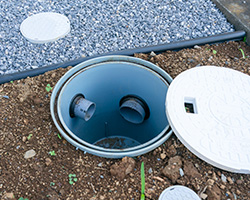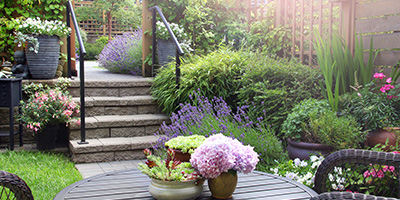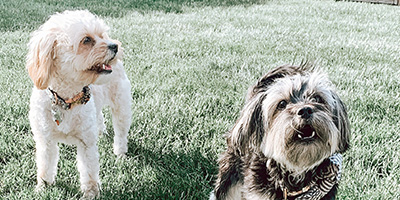How to Improve Drainage in Your Yard

Yard Drainage Solutions You Can Do Yourself
Every homeowner knows the value of keeping up their home's curb appeal. So what do you do when pools of water disrupt your beautiful yard? Identify the underlying cause, then get to work on the solution. Luckily, most yard drainage problems can be traced back to a fixable cause — often one you can tackle yourself.
Standing water is the most common sign your yard is not draining properly. Flooded tree roots and overflowing gutters are other symptoms to look out for.
Even if you’re not worried about curb appeal, addressing poor drainage matters, as pooling water can lead to a variety of serious problems. This includes foundation damage, peeling paint, basement flooding and even mold. It’s important to resolve these issues as soon as they appear to prevent further damage.
6 Common Causes of Drainage Problems
Here are some of the most common drain issues in yards.
1. Yard Slope or Pitch
Ideally, your yard should be sloped in a way that allows water to drain away from your home. If you notice your yard isn’t draining, it may be because the soil wasn’t graded properly.
What’s the First Sign?
- Large puddling in one spot
What Can Happen if I Don’t Fix It?
- Soggy soil and mud
- Brown patches of grass
- Foundation damage
- Mold growth

“If your yard rests towards the bottom of a hilly area, water will begin to pool in the lowest sections of the yard since it has nowhere else to go.”
Conor Battles | The Basement Guys Cleveland
2. Impacted Soil
Have you recently installed a pool in your yard? This type of construction project can pack your soil so tightly that it can’t drain. Hardpan clay is especially problematic when impacted since it can retain moisture longer than other types of soil. Natural underground springs can also cause too much moisture and contribute to impacted soil.
What’s the First Sign?
- Hard and dense soil
- Pooling water, especially in areas where you’ve completed projects
What Can Happen if I Don’t Fix It?
- Low spots in your yard
- Root rot
- Mold growth
- Erosion

“Most yard drainage issues are caused by homeowner projects. When developers set up a master plan, drainage is usually set correctly. Unfortunately, when people move into their home, they install things like pools and gazebos that disrupt the soil.”
Robert Sherwood | French Drain Man
3. Short Gutter Downspout
Your gutter is designed to direct water away from the foundation of your home, but water can still puddle if the downspout isn’t long enough.
What’s the First Sign?
- Big puddles under your downspout
What Can Happen if I Don’t Fix It? - Foundation damage
- Basement flooding
- Mold growth
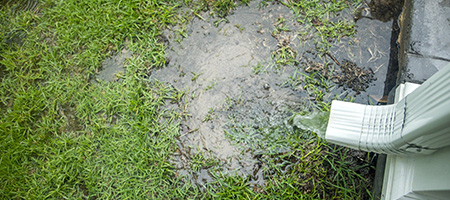
4. Barriers Like Sidewalks, Walkways and Rocks
If a sidewalk or concrete path sits in front of your house, it may be the cause of flooding in your yard. When sidewalks are installed at a higher elevation than the surface of your soil, water can flow off the sidewalk and into your yard.
What’s the First Sign?
- Standing water in low spots
What Can Happen if I Don’t Fix It?
- Erosion
- Mosquito attraction
- Foundation damage
5. Runoff Erosion
Runoff from stormwater and your downspout can strip away some of the topsoil in your yard. As topsoil is washed away, your yard is left with the compacted dirt below that can't absorb water easily. Water will begin to collect in these places, and as topsoil keeps eroding, you'll see more and more flooding.
What’s the First Sign?
- Thin, patchy areas of grass
What Can Happen if I Don’t Fix It? - Exposed tree roots
- Damaged plant beds
- Foundation damage
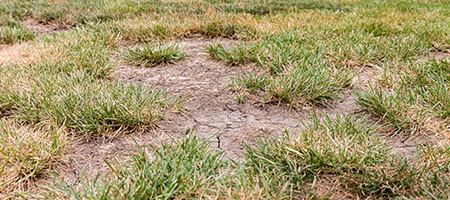
6. Broken Water or Sewer Lines
Excessive water pressure can cause water lines to break and leak underground. If you have a septic tank, keep an eye on standing water near the unit or drain field — this is an indication of septic tank flooding.
What’s the First Sign?
- Low water pressure
What Can Happen if I Don’t Fix It? - Wet spots in yard
- Discolored or odored water
- High water bills
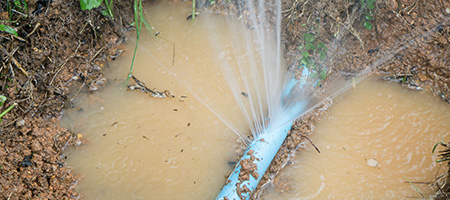
8 Yard Drainage Solutions You Can Do Yourself
Once you’ve identified your issue and the most likely cause, you can use one of the following lawn drainage solutions.
Quick and Easy Lawn Drainage Solutions
Once you’ve identified your issue and the most likely cause, you can use one of the following lawn drainage solutions.
1. Water Less Often
If there’s no clear cause of your drainage problems, it’s possible that you’re overwatering your yard or garden. Cut down on your watering and watch to see if the trouble spots improve. If they do, the soil could be draining properly but simply can’t keep up with your watering schedule. If not, it may be time to get your hands dirty.

“Maintaining a dry yard is a crucial part of homeownership. When water is allowed to accumulate, especially near the foundation or other vulnerable parts of the home, it can often lead to leaks and other issues that can balloon into a much bigger problem.”
Conor Battles | The Basement Guys Cleveland
2. Add More Dirt
If you only have a few shallow areas in your yard that collect water after a rainfall, add dirt to those spots. Simply scatter topsoil over the low spots and rake it in.
Think your yard needs a thorough grade correction? Place a level against the soil directly surrounding your home’s foundation. If it is graded correctly, the ground will drop about 1 inch for every foot that you move away from the house. If it doesn’t, add more soil around your house. Make sure the soil does not come into contact with your siding. You should see at least 4 inches of your concrete foundation above the soil.
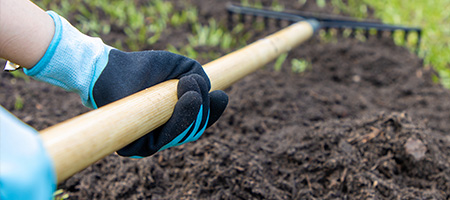

Pro Tip: If you discover damage to your home’s foundation, make sure to correct it before adding dirt. Water can seep into dirt and eat away at already compromised materials.
3. Extend Your Downspout
If you find that the runoff causing your yard drainage problems is coming from your gutter system, try extending the downspout away from your house so it doesn’t form a basin. Just make sure that you point the extended downspout towards a storm drain or other safe drainage area, not a neighboring property.
While you’re at it, make sure the gutters themselves are working properly. Blocked or faulty gutters can cause water to overflow, leading to costly damage. If your roof turns into a waterfall every time it rains, it may be time to tackle a few gutter repairs. At the very least, check that they are clear of debris and pests.
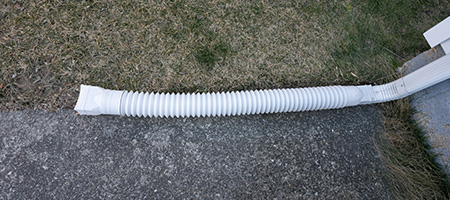

“An easy way to ensure that your yard is protected from unnecessary water intrusion is to make sure that your gutters, downspouts and discharge lines are all working properly. This helps keep water from accumulating in the yard and potentially breaching your foundation, leading to leaks and other home safety concerns.”
Conor Battles | The Basement Guys Cleveland
4. Aerate Your Grass
Aerating your yard creates holes in the lawn and breaks up compacted soil underneath. This yard drainage solution allows air, nutrients and water to reach the roots of your grass, reducing runoff.
You can rent an aerator from a local home improvement store or use a manual spike aerator. Whichever tool you choose, make sure to rake up loose sticks and debris from your lawn before using it. After you’re finished aerating, leave the extra soil to break down naturally. For optimal results, add fertilizer after aeration.
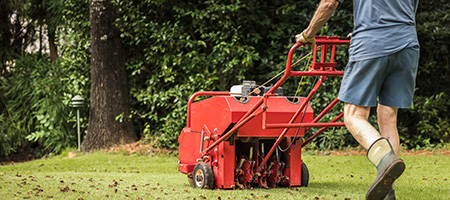
5. Remove Large Rocks
Decorative rocks in your yard, if not placed properly, can also create barriers to runoff, causing water to pool in undesirable locations. Consider relocating or removing some rocks to ensure rainwater has a clear path out of your yard.
Have lots of yard waste on your hands? Here are the best ways to get rid of it.
More Advanced DIY Yard Drainage Solutions
If our quick and easy solutions aren’t doing the trick, here’s how to fix water drainage problems in your yard with a little more effort.
6. Dig a Creek Bed or Swale
Installing a creek bed is a solution to backyard flooding that works well and looks good, too. It creates a drainage channel and redirects water away from your house in a way that can really level up your landscaping look. Similarly, a swale is a sunken area that collects water, but does not contain as many rocks.
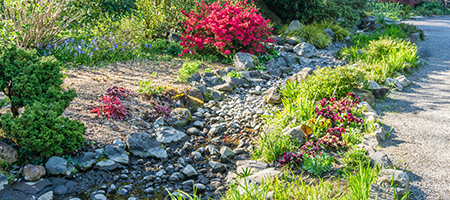
- Once you decide where you want the creek bed to go, mark the spot with stakes.
- Use a shovel or excavator to remove the top layer of soil. The bed should have a gradual slope of about 1 inch per every 10 feet. Use a level to check the slope.
- Cover the trench with landscape fabric.
- Add a layer of small rocks.
- Start running water from your hose to the bed and test the flow. Make sure the water doesn’t pool in any areas.
- For a visual boost, surround the bed with plants.
7. Construct a Rain Garden
Consider turning your soggy patch into a rain garden to catch rainfall so it doesn’t flood your yard. Rain gardens are usually filled with water-loving plants like hostas, ferns and ornamental mosses that help dry out saturated areas. They don’t necessarily solve the yard drainage issue, but they’re definitely more attractive than a muddy hole full of soaked grass.
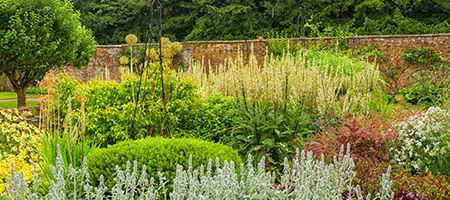
A completed rain garden will ideally drain water within 24 hours. This number, as well as how absorbent your soil is, can help you figure out how deep to dig the garden. You can dig a small hole in the area, fill it with water, and watch how fast it drains as a test to help determine the right depth. Your rain garden can also be the ending point of a downspout or creek bed.
8. Install a French Drain or Dry Well
What’s the Difference?
Dry wells and French drains are different lawn drainage solutions. A French drain is a very effective pipe drainage system that channels runoff water to a single point. While dry wells can be helpful, they aren’t effective during the rainy seasons when soils are saturated.

“Unlike a dry well, a French drain discharges to a storm drain or a ditch. Since it goes somewhere and you're able to discharge water, it works really well.”
Robert Sherwood | French Drain Man
French Drain | Dry Well |
|---|---|
|
|
A French drain absorbs surface water to prevent flooding. It's typically built by digging a long trench, which is then filled with gravel or rocks and a drainage pipe that runs all the way down the trench. | A dry well holds water and prevents overflowing drains. It’s usually installed at the endpoint of a creek bed, swale or French drain. It collects and disperses water into the surrounding soil instead of redirecting water away from the house. |
How to Install a French Drain
Digging a hole is hard work, but you can create a DIY French drain in a few steps. If you’re not sure where to start on gathering the right supplies, consider investing in a French drain kit.
- Identify the area in your yard that needs a rain drainage solution. Make sure the drain is at least 10 feet away from your house or septic system. Decide what type of drainage system you want to send your water to.
- Dig the trench with a shovel or trenching machine. The trench should be about 18 inches wide and 24 inches deep, depending on the size of your pipe. The trench should slope downhill, away from your home. Hand digging is easiest in the spring, when the soil is still wet.
- Line the trench with landscaping fabric and secure it with sod staples. This will keep dirt, roots and other debris from clogging the drain system.
- Place the drain pipe in the trench. Check that the pipe has a continuous downward slope. Your drain should slope downward at least 1 inch for every 10 feet of pipe. The pipe should run from your home’s downspout to a storm drain.
- Add a gravel layer around the pipe. Fill the trench to about 2 inches below the surface.
- Finish installation with a layer of topsoil and plant grass to backfill the trench. Alternatively, you can keep the sod you originally dug up and place it over the top. Water the area periodically as it dries out.
How to Install a Dry Well
Installing a dry well involves an almost identical process to installing a French drain. Just make sure the hole for your dry well is about 4 feet deep and the pipe running toward the dry well slopes one-quarter inch per foot.


